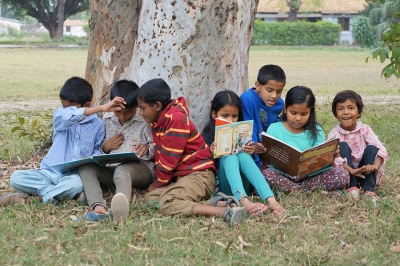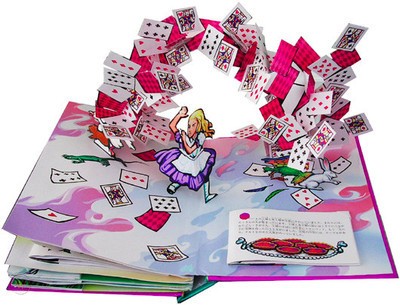Which are the children’s favourite Indian authors?

Simple and relatable
R.K. Narayan is the one of the indian authors I love. I enjoy reading his Malgudi Days in which he has woven together different stories from the depth of his own imagination and created the imaginary town of Malgudi. His language is rich and beautiful and he writes with sheer simplicity. Another author I admire is Ruskin Bond. At the end of every page, he leaves me with the feeling that there should be more to the story. His books are intriguing and appealing. I also love reading Sudha Murthy. She writes in simple English and in a down to earth manner. Her stories are realistic and all of us can relate to them. She teaches us important lessons such as ethics through her books.
Adventures ahead
Three Indian authors whom I like are Satyajit Ray, Ruskin Bond, and R.K. Narayan. When it comes to thrill, adventure, and suspense, Ray's books are my first preference. Ray has the ability to keep readers engrossed throughout the entire book. His art of keeping the suspense intact till the end and his contextual choice of words and phrases is extraordinary. On a different plane is R.K. Narayan, whose stories are based on real-life situations and human reactions to day-to-day happenings in the imaginary town of Malgudi. His protagonist Swami is loved by all. To a city-grown kid like me, Narayan excellently projects the interesting life in the villages. Last, but not the least, I love Ruskin Bond for opening my imagination to the beauty of nature. Bond's stories bring alive the spirit of mountains, landscapes, seasons, and the simplicity of hill-folks, who form the prime characters in his stories.
Gopi, Mini and mystery
The three Indian authors I enjoy reading are Sudha Murty, Ravi Subramanian, and Nandini Nayar I like Murty's "The Gopi Daines" because it is an amazing adventure of a dog. It tells the story of how Gopi came to live with Murty's family. I like Ravi Subramanian's 'The Mystery of School on Fire", which is a fascinating mystery. It has lots of twists. Towards the end of the book, the three protagonists solve the problem smartly. I also liked Nandini Nayars "Mini" books. I enjoyed reading about Mini's summer holiday with monsters. I felt it was an extremely creative and interesting story for young kids.
Unique writing styles
The three Indian authors whom I enjoy reading are Sudha Murty, Ruskin Bond and Rudyard Cipling. I like Sudha Murty's stories because many of them are based on real life experiences. He stories inspired me a lot.
I like Ruskin Bond's stories because they are descriptive and interesting to read. He has a knack for describing places, people and things so well that I feel like I am one of the characters. I like Rudyard Kipling's stories because he writes from the perspective of animals. His stories press the thoughts, feelings and emotions of animals. Animal lovers would love to read his books.
Ray, Premchand and Bond
The three Indian authors I like are - Satyajit Ray, Premchand, and Ruskin Bond. Firstly,
I like Satyajit Ray's book "The Adventures of Feluda". Rays keeps the stories short yet funny, and informative. Also, he weaves in lesser-known facts into his work. For example, in one of his stories Ray mentions that most people choose number 7 if asked to pick from 1 to 10. His stories do not drag unlike other novels in which the detectives often have a tendency to lecture the readers. On the other hand, Premchand's stories are based on people's daily lives. He tries to teach us morals through his stories. Some of my favourite stories from Premchand are the "Old Mother' and the 'Tale of Two Cows". And lastly, I like Ruskin Bond's books. They are full of adventures, and sometimes also include evil spirits and animals. Some of my favourites are "The Blue Umbrella", "The Adventures of Rusty" and "Burning Bright' his new book on Jim Corbett. All of these authors hold a special place in the world of literature.
Different styles
Three Indian authors I enjoy reading the most are Ruskin Bond Sudha Murty and R.K. Narayan Ruskin Bond has a unique style of writing and his way of describing-especially nature-makes scenes and the backdrops very vivid. His books always have bits of humour, which make you laugh even in an otherwise serious story.
Sudha Murty's stories, on the other hand, are simple and interesting with an Indian flavour added to them. Most of her books make us appreciate the unique culture that our country has. I will always keep her book, The Magic of the Lost Temple to be among my favourites.
Though in contrast to Sudha Murthy's style of writing, R.K. Narayan, too, has the same way of narrating Indian heritage, especially village life in his books. Unusual friendships and emotional endings make his stories memorable.
Ruskin Bond, R.K. Narayan, and Rabindranath Tagore
The three Indian authors I enjoy reading are Ruskin Bond, R.K Narayan and Rabindranath Tagore. I have been reading their stories from a young age and their works have had an impact on me. Ruskin Bond's stories are unique because they can be light-hearted and at the same time some will leave you searching for answers. A lot of his stories are set in Northern India - mostly in Mussoorie. Shimla and Agra and the stories often revolve around his childhood. Reading them is always a memorable experience. When it comes to R.K. Narayan. "Malgudi Adventures" is one of the first books I read. Set in the fictional South Indian town of Malgudi, the characters are quite charming. Swaminathan and his friends immediately found a place in my heart as their childishness was something I could relate to. Rabindranath Tagore's short stories like "Kabuliwala" and "Postman" are quite emotional and touching.
Historical fiction and real-life stories
Three Indian authors who I like reading are Kalki Krishnamurthy, Sudha Murty and Ruskin Bond. Kalki is well known for his amazing historical fiction novel "Ponniyin Selvan". His books have vast imagination and creativity. And his description of a place makes us relive them. Through his selective choice of words, he makes his books a better read. Sudha Murthy's stories always enrich life values. Her stories are based on incidents in her life and they are filled with emotions. Her stories teach us how to act in certain situations. Ruskin Bond is a famous author whose stories also feature some of his life stories. His works are interesting and they develop a curiosity. These three authors have a unique style of writing and I feel such story writers are important for this world.
A mixed bag of stories
Ruskin bond, Sudha Murty and R.K. Narayan are my favourite Indian authors. They have unique styles of storytelling and that's what I love. Ruskin Bond's "The Children's Omnibus" is a book that deals with folktales, scenes from his life and many moral stories. I still remember laughing out loud while reading "My Failed Omelettes".
Sudha Murty's "Grandma's Bag of Stories" is a very nice book, which has moral stories and they taught me many things. Her classical stories are the ones everyone will appreciate. And I am also a huge fan of R.K. Narayan's "Malgudi Adventures" which has 17 stories revolving around the town of Malgudi. One of the stories "A Tiger In The School" which is about a tiger entering an empty school - is of my favourite stories by the author.
Uncle Pai, Bond and Ray
I am a fan of detective stories, so I love reading Satyajit Ray's "Feluda" series. The way Feluda solves mysteries are amazing. The stories are so thrilling that the books are really unputdownable.
Ruskin Bond's stories are often about beautiful friendship and human-animal interactions. I like his stories as they are interesting yet simple and create a desire in me to live a life like his. It is so amazing to see how he uses simple words and detailed observations to make everyday stories exciting. Anant Pai is the creator of Tinkle", a magazine that I love a lot. His stories are so funny it makes my sides ache with laughter. Characters like Ramu and Shamu, and Kapish, are the ones he created. He has also written the "Amar Chitra Katha" series which brings Indian mythology to life.
Kalam, Murty and Narayan
Sudha Murty is a great author. I read her books as they are very interesting. While reading her books it makes me feel that I am one of the characters in the book. She also teaches moral values in her writings. R.K.Narayan's writings revolve around the daily lives of common people. Malgudi is created by him, as a place where the stories occur. The stories are humorous and realistic. We feel that it is happening in our presence. I enjoyed reading books written by A.PJ Abdul Kalam. He writes with clarity and it is easy to read. I have read his autobiography and it is really inspiring.
He was a great scientist and became the president of India and yet remained a really humble person and a great soul.
Of mythologies and nature
I usually like reading books by foreign authors such as Jeff Kinney, Dan Brown, Agatha Christie, and Enid Mary Blyton. But I liked the books by Indian authors as well.
One of three Indian authors I like the most is Amish Tripathi. He is an alumnus of Indian Institute of Management, Calcutta. He started his writing career with the "Immortals of Meluha", the first novel in the "Shiva Trilogy". It's my favourite. Tripathi usually writes mythological novels with his own twist. I hope he will keep writing books to enrich our mind.
The second-best Indian author I like is Ruskin Bond. According to me, he is the one of the most famous Indian authors. Bond is of British descent. He started his career with "Room On The Roof' in 1856, which won John Llewellyn Rhys Prize in 1957. He was awarded the Sahitya Akademi Award in 1992 for "Our Trees Still Grow in Dehra".
Rasipuram Krishnaswami lyer Narayanaswami, commonly known as R. K. Narayan is my third favourite author. He is from South India. His book "Malgudi Days" is set in the fictional village Malgudi. He is one of the greatest authors ever in Indian history.
Picture Credit : Google


